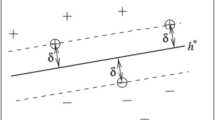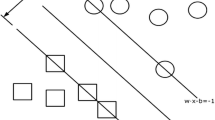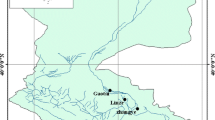Abstract
The accurate predictions of ground ozone concentrations are required for proper management, control, and making public warning strategies. Due to the difficulties in handling phenomenological models that are based on complex chemical reactions of ozone production, neural network models gained popularity in the last decade. These models also have some limitations due to problems of overfitting, local minima, and tuning of network parameters. In this study, the predictions of daily maximum ozone concentrations are attempted using support vector machines (SVMs). The comparison between the accuracy of SVM and neural network predictions is performed to evaluate their performance. For this, the daily maximum ozone concentration data observed during 2002–2004 at a site in Delhi is utilized. The models are developed using the available meteorological parameters. The results indicated the promising performance of SVM over neural networks in predicting daily maximum ozone concentrations.
Similar content being viewed by others
References
Bishop, C. M. (1995). Neural networks for pattern recognition. New York: Oxford University Press.
Box, G. E. P., & Jenkins, G. M. (1970). Time series analysis, forecasting and control. San Francisco, CA: Holden-Day.
Canu, S., & Rakotomamonjy, A. (2001). Ozone peak and pollution forecasting using support vector. Yokohama: IFAC Workshop on Environmental Modeling.
Chelani, A. B., Gajghate, D. G., & Hasan, M. Z. (2002). Prediction of ambient PM10 and toxic metals using artificial neural networks. Journal of the Air & Waste Management Association, 52, 805–810.
Comrie, A. (1997). Comparing neural networks and regression models for ozone forecasting. Journal of the Air & Waste Management Association, 47, 653–663.
Gardner, M. W., & Dorling, S. R. (1998). Artificial neural networks (the multilayer perceptron)—a review of applications in the atmospheric sciences. Atmospheric Environment, 32(14/15), 2627–2636. doi:10.1016/S1352-2310(97)00447-0.
Heck, W. W., Adams, R. M., Cure, W. W., Heakle, A. S., Heggested, H. E., Kohut, R. J., et al. (1983). A re-assessment of crop loss from ozone. Environmental Science & Technology, 17, 572A–581A.
Lu, W. Z., & Wang, W. J. (2005). Potential assessment of the ‘support vector machine’ method in forecasting ambient air pollutant trends. Chemosphere, 59, 693–701. doi:10.1016/j.chemosphere.2004.10.032.
Mukherjee, S., Osuna, E., & Girosi, F. (1997). Nonlinear prediction of chaotic time series using support vector machines. In Proceedings of the IEEE workshop on neural networks for signal processing, Amelia Island, FL (pp. 511–520).
Prybutok, V. R., Yi, J., & David Mitchell, D. (2000). Comparison of neural network models with ARIMA and regression models for prediction of Houston’s daily maximum ozone concentrations. European Journal of Operational Research, 122, 31–40. doi:10.1016/S0377-2217(99)00069-7.
Raimondo, G., Montuori, A., Moniaci, W., Pasero, E., & Almkvist, E. (2007). A machine learning tool to forecast PM10 level. In Proceedings of the fifth conference on artificial intelligence applications to environmental science. Retrieved from http://ams.confex.com/ams/87ANNUAL/techprogram/paper_119708.htm.
Robeson, S. M., & Steyn, D. G. (1990). Evaluation and comparison of statistical forecast models for daily maximum ozone concentrations. Atmospheric Environment, 24B, 303–312.
Schlink, U., Dorling, S., Pelikan, E., Nunnari, G., Cawley, G., Junninen, H., et al. (2003). A rigorous inter-comparison of ground-level ozone predictions. Atmospheric Environment, 37, 3237–3253. doi:10.1016/S1352-2310(03)00330-3.
Sewell, M. (2005). WinSVM software. Retrieved from http://www.cs.ucl.ac.uk/staff/M.Sewell/winsvm.
Smola, A. J., & Scholkopf, B. (1998). A tutorial on support vector regression. NeuroCOLT technical report NC-TR-98-030, Royal Holloway College, University of London, UK. Retrieved from http://www.kernel-machines.org.
Thissen, U., van Brakel, R., de Weijer, A. P., Melssen, W. J., & Buydens, L. M. C. (2003). Using support vector machines for time series prediction. Chemometrics and Intelligent Laboratory Systems, 69, 35–49. doi:10.1016/S0169-7439(03)00111-4.
Vapnik, V. (1998). Statistical learning theory. New York: Springer.
Welch, G., & Bishop, G. (2001). An Introduction to the Kalman Filter. Retrieved from http://info.acm.org/pubs/toc/CRnotice.html.
Yi, J., & Prybutok, R. (1996). A neural network model forecasting for prediction of daily maximum ozone concentration in an industrialized urban area. Environmental Pollution, 923, 349–357. doi:10.1016/0269-7491(95)00078-X.
Author information
Authors and Affiliations
Corresponding author
Rights and permissions
About this article
Cite this article
Chelani, A.B. Prediction of daily maximum ground ozone concentration using support vector machine. Environ Monit Assess 162, 169–176 (2010). https://doi.org/10.1007/s10661-009-0785-0
Received:
Accepted:
Published:
Issue Date:
DOI: https://doi.org/10.1007/s10661-009-0785-0




